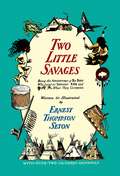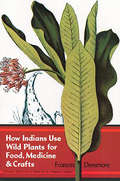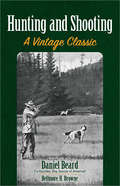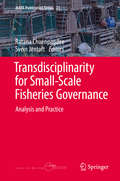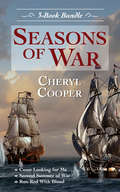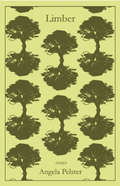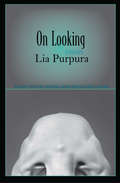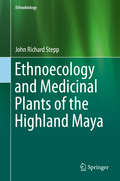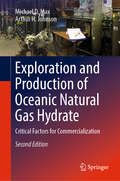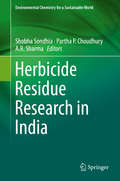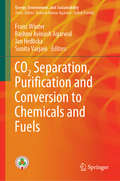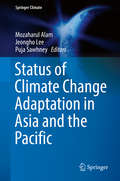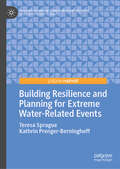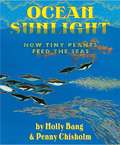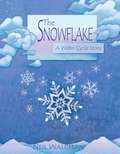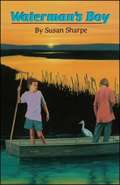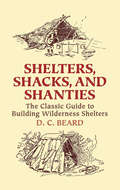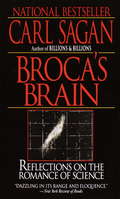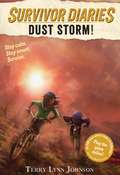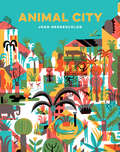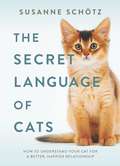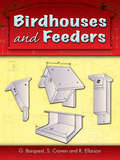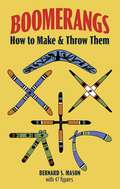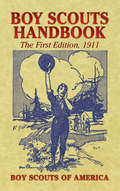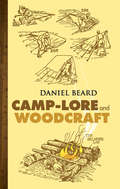- Table View
- List View
Two Little Savages: Being the Adventures of Two Boys Who Lived as Indians and What They Learned
by Ernest Thompson SetonThis is one of the great classics of nature and boyhood by one of America's foremost nature experts. It presents a vast range of woodlore in the most palatable of forms, a genuinely delightful story. It will provide many hours of good reading for any child who likes the out-of-doors, and will teach him or her many interesting facts of nature, as well as a number of practical skills. It will be sure to awaken an interest in the outdoor world in any youngster who has not yet discovered the fascination of nature.The story concerns two farm boys who build a teepee in the woods and persuade the grownups to let them live in it for a month. During that time they learn to prepare their own food, build a fire without matches, use an axe expertly, make a bed out of boughs; they learn how to "smudge" mosquitoes, how to get clear water from a muddy pond, how to build a dam, how to know the stars, how to find their way when they get lost; how to tell the direction of the wind, blaze a trail, distinguish animal tracks, protect themselves from wild animals; how to use Indian signals, make moccasins, bows and arrows, Indian drums and war bonnets; how to know the trees and plants, and how to make dyes from plants and herbs. They learn all about the habits of various birds and animals, how they get their food, who their enemies are and how they protect themselves from them.Most of this information is not generally available in books, and could be gained otherwise only by years of life and experience in suitable surroundings. Yet Mr. Thompson Seton explains it so vividly and fully, with so many clear, marginal illustrations through the book, that the reader will finish "Two Little Savages" with an enviable knowledge of trees, plants, wild-life, woodlore, Indian crafts and arts, and survival information for the wilds. All of this is presented through a lively narrative that has as its heroes two real boys, typically curious about everything in the world around them, eager to outdo each other in every kind of endeavor. The exciting adventures that befall them during their stay in the woods are just the sort of thing that will keep a young reader enthralled and will stimulate his or her imagination at every turn.
How Indians Use Wild Plants for Food, Medicine & Crafts
by Frances Densmore"Learn the natural ways of the Chippewa Indians with this great book from Dover." — Texas Kitchen and Garden and MoreThe uses of plants — for food, for medicine, for arts, crafts, and dyeing — among the Chippewa Indians of Minnesota and Wisconsin show the great extent to which they understood and utilized natural resources. In this book those traditions are captured, providing a wealth of new material for those interested in natural food, natural cures, and native crafts.In separate sections describing the major areas of use, Miss Densmore, an ethnologist with the Smithsonian Institution, details the uses of nearly 200 plants with emphasis on wild plants and lesser-known uses. For those interested in natural foods she gives extensive coverage to the gathering and preparation of maple sugar and wild rice, as well as preparations for beverages from leaves and twigs of common plants, seasonings including mint and bearberry, the methods of preparing wild rice and corn, cultivated and wild vegetables, and wild fruits and berries. On Indian medicines she tells the basic methods of gathering plants and the basic surgical and medical methods. Then she gives a complete list of the plants with their botanical names, uses, parts used, preparation and administration, and other notes and references. Also covered are plants used as charms, plants used in natural dyes, and plants in the useful and decorative arts including uses for household items, toys, mats, twine, baskets, bows, and tools, with special emphasis on the uses of birch bark and cedar. This section will be especially useful for supplying new and unusual craft ideas. In addition, 36 plates show the many stages of plant gathering and preparation and many of the artistic uses. While a number of the plants discussed are native only to the Great Lakes region, many are found throughout a wide range.Those studying the Indians of the Great Lakes region, or those trying to get back to nature through understanding and using natural materials, will find much about the use of plants in all areas of community life. Because of Miss Densmore’s deep knowledge and clear presentation, her study remains a rich and useful source for learning about or using native foods, native cures, and native crafts.
Hunting and Shooting: A Vintage Classic
by Daniel Beard Bellmore H. BrowneBoy Scouts co-founder and avid outdoorsman "Uncle Dan" Beard offers young readers a clear, enthusiastic introduction to the joys of hunting in this timeless guide. Together with Bellmore H. Browne, an expert mountaineer and big-game hunter, Beard provides practical advice on setting up decoys and blinds as well as useful pointers for everything from shooting waterfowl to upland hunting for quail and grouse. Originally published a century ago, this engagingly written and charmingly illustrated guide imparts timeless wisdom that includes respect for weapons and nature, commonsense safety tips, and helpful hints for enjoying the outdoors. In addition to discussions of trap and field shooting, the authors include a brief survey of the history of firearms and guidance on preparing for a hunting trip. Parents wishing to share the sport of hunting with their growing children will find this classic an ideal place to begin.
Transdisciplinarity for Small-Scale Fisheries Governance: Analysis And Practice (Mare Publication Ser. #21)
by Ratana Chuenpagdee Svein JentoftThe importance of small-scale fisheries for sustainable livelihoods and communities, food security, and poverty eradication is indisputable. With the endorsement of the ‘Voluntary Guidelines for Securing Sustainable Small-Scale Fisheries’, FAO member states recognize that governments, civil society organizations, and research communities all have a role to play in helping small-scale fisheries achieve these goals. This book argues that policies targeting small-scale fisheries need to be based on a solid and holistic knowledge foundation, and support the building of governance capacity at local, national, and global levels. The book provides rich illustrations from around the world of why such knowledge production needs to be transdisciplinary, drawing from multiple disciplinary perspectives and the knowledge that small-scale fisheries actors have, in order to identify problems and explore innovative solutions. Transdisciplinarity for Small-Scale Fisheries Governance: Analysis and Practice, edited by Ratana Chuenpagdee and Svein Jentoft, successfully demonstrates how small-scale fisheries are important and what social and political conditions are conducive to their wellbeing. The volume contributes tremendously to building capacity of fisheries communities and policy-makers to make the ideals of small-scale fisheries a reality. It establishes the ecological, social, and economic sense behind small-scale fisheries. A milestone reference for all those who believe in small-scale fisheries and are keen to defend them with quality evidence!— Sebastian Mathew, Executive Director, International Collective in Support of Fishworkers (ICSF)The Small-Scale Fisheries Guidelines guiding principles call for holistic and integrated approaches for their implementation. This book will help a new generation of scientists, policy-makers, and small-scale fisheries actors make the fundamental connections between different disciplines in science, traditional knowledge, and policy to guide a collective process towards sustainable small-scale fisheries. The book contains an inspiring collection of practical cases from around the world, complemented by deep dives into dimensions of small-scale fisheries, like food security, stewardship, climate change, and gender, which all call for transdisciplinary approaches.— Nicole Franz, Fisheries and Aquaculture Department, Food and Agriculture Organization of the United Nations (FAO) Rome, Italy
Seasons of War 3-Book Bundle: Come Looking for Me / Second Summer of War / Run Red With Blood (Seasons of War)
by Cheryl CooperDuring the War of 1812, a young woman with a mysterious past and connections in very high places flees England for new adventures. Book #1 – Come Looking for Me Fleeing England, a mysterious young woman named Emily risks the Atlantic during the War of 1812 for a new adventure in Canada. She never arrives. Deadly sea battles with Americans and a ship's captain hell-bent on revenge make her crossing treacherous, terrifying, and, should her true identity be revealed, tragic. Book #2 – Second Summer of War A tale of life on the sea in the summer of 1813, through England's stodgy salons and horrific prison hulks, and into the bloody battles between the British and the Americans on the storm-tossed Atlantic. Book #3 – Run Red with Blood Disguised as a man, Emily steals aboard Fly Austen's frigate only to find herself up against unpleasant passengers, Atlantic storms, and battles with the Americans.
Limber: Essays
by Angela Pelster"What a strange and unexpected treasure chest this is, filled with all manner of quirky revelations, all about the mundane sublime and the ineffable extraordinary. Most extraordinary of all, perhaps, through, is the haunting perfection, sentence by sentence, paragraph by paragraph, of the writing itself. Who is this Angela Pelster and where has she been all our lives?"-Lawrence WeschlerAngela Pelster's startling essay collection charts the world's history through its trees: through roots in the ground, rings across wood, and inevitable decay. These sharp and tender essays move from her childhood in rural Canada surrounded by skinny poplar trees in her backyard to a desert in Niger, where the "Loneliest Tree in the World" once grew. A squirrel's decomposing body below a towering maple prompts a discussion of the science of rot, as well as a metaphor for the ways in which nature programs us to consume ourselves. Beautiful, deeply thoughtful, and wholly original, Limber valiantly asks what it means to sustain life on this planet we've inherited.Angela Pelster's essays have appeared in Granta, the Gettysburg Review, Seneca Review, the Globe and Mail, Relief Magazine, and others. Her children's novel The Curious Adventures of India Sophia won the Golden Eagle Children's Choice award in 2006. She has an MFA from the University of Iowa's nonfiction writing program and lives with her family in Baltimore, Maryland, where she teaches at Towson University.
On Looking: Essays
by Lia Purpura"Purpura is the real deal, and so is every successive sentence in this collection. A cornucopiac vocabulary is married to a strict economy of expression; an offbeat curiosity is married to the courage of difficult witnessing. . . ."--Albert Goldbarth"Purpura's prose is a system of delicate shocks--leaps and connections and syncopated revelations, all in the service of the spirit negotiating the truth of its experience."--Sven BirkertsLia Purpura's daring new book of lyric essays, On Looking, is concerned with the aesthetics and ethics of seeing. In these elegantly wrought meditations, patterns and meanings emerge from confusion, the commonplace grows strange and complex, beauty reveals its flaws, and even the most repulsive object turns gorgeous. Purpura's hand is clearly guided by poetry and behaves unpredictably, weaving together, in one lit instance, sugar eggs, binoculars, and Emerson's words: "I like the silent church before the sermon begins."In "Autopsy Report," Purpura takes an intimate look at the ruin of our bodies after death, examining the "dripping fruits" of organs and the spine in its "wet, red earth." A similar reverence is held for the alien jellyfish in "On Form," where she notes that "in order to see their particular beauty...we have to suspend our fear, we have to love contradiction." Her essays question art and its responses as well as its responsibilities, challenge familiar and familial relationships, and alter the borders between the violent and the luminous, the harrowing and the sensual. Above all, Purpura's essays are a call to notice. She is writer-as-telescope, kaleidoscope, microscope, and mirror. As she says: "By seeing I called to things, and in turn, things called me, applied me to their sight and we became each as treasure, startling to one another, and rare." This is, indeed, a rare and startling treasure of a book.Lia Purpura is the author of Increase (essays), Stone Sky Lifting (poems), The Brighter the Veil (poems), and Poems of Grzegorz Musial: Berliner Tagebuch and Taste of Ash (translations). Her awards include a National Endowment for the Arts Fellowship in Prose, a Pushcart Prize, a Fulbright Fellowship, the Associated Writing Programs Award in Creative Nonfiction, and the Ohio State University Press/The Journal Award in Poetry. Her poems and essays have appeared in Agni, DoubleTake, The Georgia Review, The Iowa Review, Parnassus: Poetry in Review, Ploughshares, and elsewhere. She is Writer-in-Residence at Loyola College in Baltimore, Maryland, and teaches at the Rainier Writing Workshop MFA Program in Tacoma, Washington.
Ethnoecology and Medicinal Plants of the Highland Maya (Ethnobiology Ser.)
by John Richard SteppPlants play a central role in human existence. Medicinal plants, in particular, have allowed for the continued survival of the human species. This book, based on over a decade of research in Southern Mexico with the Highland Maya, explores the relationship between medicinal plants, traditional ecological knowledge and the environment. The biodiversity of the region remains among the highest in the world, comprising more than 9000 plant species. Over 1600 employed for medicinal uses and knowledge for approximately 600 species is widespread. Medicinal plants play an overwhelmingly primary role in the daily health care of the Highland Maya. Three principal objectives are addressed: 1) identifying which medicinal plants are used; 2) determining the role of environmental variation on use and selection of medicinal plants; and 3) identifying which habitats are preferred for medicinal plant procurement. Findings demonstrate the overwhelming importance of human modified environments for medicinal plants. Explanations are presented from human ecology and biochemical ecology. Implications for conservation, health and the environment are discussed.
Exploration and Production of Oceanic Natural Gas Hydrate: Critical Factors For Commercialization
by Michael D. Max Arthur H. JohnsonThis second edition provides extensive information on the attributes of the Natural Gas Hydrate (NGH) system, highlighting opportunities for the innovative use and modification of existing technologies, as well as new approaches and technologies that have the potential to dramatically lower the cost of NGH exploration and production.Above all, the book compares the physical, environmental, and commercial aspects of the NGH system with those of other gas resources. It subsequently argues and demonstrates that natural gas can provide the least expensive energy during the transition to, and possibly within, a renewable energy future, and that NGH poses the lowest environmental risk of all gas resources.Intended as a non-mathematical, descriptive text that should be understandable to non-specialists as well as to engineers concerned with the physical characteristics of NGH reservoirs and their production, the book is written for readers at the university graduate level. It offers a valuable reference guide for environmentalists and the energy community, and includes discussions that will be of great interest to energy industry professionals, legislators, administrators, regulators, and all those concerned with energy options and their respective advantages and disadvantages.
Herbicide Residue Research in India (Environmental Chemistry for a Sustainable World #12)
by Shobha Sondhia Partha P. Choudhury A. R. SharmaHerbicides constitute about 60% of the total pesticides consumed globally. In India, the use of herbicides started initially in tea gardens and picked up in the 1970s, when the high-yielding varieties of rice and wheat were introduced. Presently, 67 herbicides are registered in the country for controlling weeds in crops including cereals, pulses, oilseeds, fibre and tuber crops, and also in the non-crop situations. These chemicals are becoming increasingly popular because of their efficiency and relatively low cost compared with manual or mechanical weeding operations. The contribution of herbicide to total pesticide use, which was only 10-15% during the first decade of the 21st century, has now increased to about 25% with an annual growth rate of 15-20%, which is much higher than insecticides and fungicides. Though the application of herbicides is minimizing yield loss to a great extent, their residues in the food chain and surface and groundwater create some environmental nuisance particularly to non-target organisms. Research on pesticide residues in India was started during 1970s, when such chemicals were introduced on a greater scale along with high-yielding variety seeds, irrigation and chemical fertilizers for increasing food production. However, the herbicide residue research was not given much emphasis until 1990s. The Indian Council of Agricultural Research initiated a national level programme known as All India Coordinated Research Project on Weed Management through the NRC-Weed Science as the main centre along with some centers of ICAR Institutes and state agricultural universities. Over the last two decades, adequate information was generated on estimation, degradation and mitigation of herbicide residues, which were documented in annual reports, bulletins, monographs and scientific articles. However, there was no consolidated compilation of all the available information providing a critical analysis of herbicide residues. Accordingly, an effort has been made in the publication to compile the available information on herbicide residues in India. This is the first report of its kind which presents the findings of herbicide residues and their interactions in the biotic and abiotic environment. There are 16 chapters contributed by the leading herbicide residue scientists, each describing the present status of herbicide use, crops and cropping systems, monitoring, degradation and mitigation, followed by conclusions and future lines of work.This book will be useful to the weed scientists in general and herbicide residue chemists in particular, besides the policy makers, students and all those concerned with the agricultural production in the country.
CO2 Separation, Purification and Conversion to Chemicals and Fuels
by Franz Winter Rashmi Avinash Agarwal Jan Hrdlicka Sunita VarjaniThis book presents the recent research on the separation, purification and downstream utilization of CO2 and other flue gases. Chapters include a detailed discussion on the purification and further conversion of CO2 to commodity chemicals and fuels. With contributions from renowned researchers in the field, the book focuses on the current challenges of catalytic high-pressure chemical conversion and biochemical conversion into high-value products. This book is of interest to researchers, professionals, and students working on carbon capture and sequestration, and is a valuable resource for policy makers and government agents working on guidelines and frameworks for carbon capture and reuse.
Status of Climate Change Adaptation in Asia and the Pacific (Springer Climate)
by Mozaharul Alam Jeongho Lee Puja SawhneyThis volume provides an overview of the climate change adaptation objectives set, actions taken, and challenges faced by several countries in the Asia-Pacific region. The majority of the populations in this region struggle to make a living from subsistence agriculture, and livelihoods are highly dependent on natural ecosystem services which are likely to be severely affected by climate change. Cases discussed in this book highlight successes made by governments towards achieving adaptation objectives, and efforts required to overcome challenges. While significant economic advances have been made, the pace of growth has been slow to impact the lives of a majority of the people who live below the poverty line. The chapters highlight adaptation actions for protecting people and their livelihoods in priority sectors, maintaining food and water security, supporting socio-economic stability including poverty reduction, and climate risk management. This book also maximizes readers' insights into the knowledge gaps and limitations of stated adaptation goals, and the bottlenecks that hinder implementation in different regions.
Building Resilience and Planning for Extreme Water-Related Events (Palgrave Studies in Climate Resilient Societies)
by Teresa Sprague Kathrin Prenger-BerninghoffThis book discusses what it means for cities to work toward and achieve resilience in the face of climate change. The content takes an urban planning perspective with a water-related focus, exploring the continued global and local efforts in improving disaster risk management within the water sphere. Chapters examine four cities in the US and Germany - San Francisco, San Diego, Solingen and Wuppertal - as the core case studies of the discussion. The chapters for each case delve into the current status of the cities and issues resilience must overcome, and then explore solutions and key takeaways learned from the implementation of various resilience approaches. The book concludes with a summary of cross-cutting themes, best-practice examples and a reflection on the relevance of the approaches to cases in the wider developing world. This book engages both practitioners and scientific audiences alike, particularly those interested in issues addressed by the Sendai Framework for Disaster Risk Reduction 2015-2030, the 2030 Agenda for Sustainable Development, the recent Water Action Decade 2018-2028 and the Rockefeller Foundation’s 100 Resilient Cities.
Ocean Sunlight: How Tiny Plants Feed the Seas (Sunlight Series)
by Molly Bang Penny ChisholmIn this timely book, acclaimed Caldecott artist Molly Bang and award-winning M.I.T. professor Penny Chisholm use poetic language and dazzling illustrations to introduce the oceanic world. From tiny aquatic plants to the biggest whale or fish, Bang and Chisholm present a moving, living picture of the miraculous balance sustaining each life cycle and food chain deep within our wondrous oceans. <P><P>On land or in the deep blue sea, we are all connected--and we are all a part of a grand living landscape. Award-winning scientist Penny Chisholm, a leading expert on oceans, packs <i>Ocean Sunlight</i> with clear, simple science, illuminated by Molly Bang's wondrous illustrations. This informative, joyous book will help children understand and celebrate the astonishing role our oceans play in human life.
The Snowflake: A Water Cycle Story
by Neil WaldmanFollows the journey of a water droplet through the various stages of the water cycle, from precipitation to evaporation and condensation.
Waterman's Boy, 1st Edition
by Susan SharpeTwo boys from a small town on the Chesapeake Bay help a scientist interested in cleaning up the water for the benefit of animals, plants, and people, while risking parental disapproval of people with too much education and of outsiders' interference in their means of earning a living.Two boys from a small Chesapeake Bay town help a scientist interested in cleaning up the water to benefit animals, plants, and people, while risking disapproval of the local residents toward people with too much education and who interfere in their meansof earning a living.
Shelters, Shacks, and Shanties: The Classic Guide to Building Wilderness Shelters
by D. C. BeardThis excellent hands-on guide by one of the founders of the Boy Scouts of America contains a wealth of practical instruction and advice on how to build everything from a bark teepee and a tree-top house to a log cabin and a sod house. No professional architects are needed here; and knowing how to use an axe is more important than possessing carpentry skills. More than 300 of the author's own illustrations and a clear, easy-to-follow text enable campers to create such lodgings as half-cave shelters, beaver mat huts, birch bark shacks, over-water camps, a Navajo hogan, and a pole house. <p><p> Additional chapters provide information on how to use an axe, split and notch logs, make a fireplace, and even build appropriate gateways to log houses, game preserves, ranches, and other open areas. An invaluable book for scouts, campers, hikers, and hunters of all ages, this guide and its fascinating collection of outdoor lore "still has intrinsic value," said Whole Earth Magazine, and will be of keen interest to any modern homesteader.
Broca's Brain: Reflections on the Romance of Science
by Carl SaganCarl Sagan, writer and scientist, returns from the frontier to tell us about how the world works. In his delightfully down-to-earth style, he explores and explains a mind-boggling future of intelligent robots, extraterrestrial life and its consquences, and other provocative, fascinating quandries of the future that we want to see today.From the Paperback edition.
Dust Storm! (Survivor Diaries)
by Terry Lynn Johnson Jani OrbanIn this thrilling addition to the high-stakes Survivor Diaries series perfect for fans of the I Survived series and Hatchet, a geocaching field trip goes awry when two tweens wander off into the desert of New Mexico.Stay calm. Stay smart. Survive. Stranded after a dust storm hits in a desert in New Mexico, sixth-graders Jen and Martin must call upon real-life skills to come to the rescue. When disaster strikes, they will have to use all their knowledge and grit to survive. With nearly twenty years of hands-on experience and training in remote areas, survivalist Terry Lynn Johnson (Ice Dogs; Sled Dog School) tells a fast-paced story featuring the real skills to prepare kids for surviving a disaster. After reading this book, you'll be better prepared for surviving a real-life disaster. Includes wilderness-survival tips from the New Mexico Search and Rescue Council.
Animal City
by Joan NegrescolorNina journeys to a secret jungle city populated by animals, plants, and lost objects. The reason for her visit: story hour, where a book's power holds the wild in thrall. The animals are eager for stories about space, the sea, and other worlds. But their favorite story of all is the one told here: a story about a mysterious place, laden with legend and lore, and now overtaken by nature. Five Pantone colors infuse each illustrated spread with a vibrant, electric energy, making this powerful celebration of nature—and stories—as vivid visually as its narrative is engrossing.
The Secret Language of Cats: How to Understand Your Cat for a Better, Happier Relationship
by Susanne SchötzHave you ever wondered what your cat is saying? Cats do not meow randomly, nor do they growl or hiss because they have nothing better to do. Cat sounds have a purpose, and they can carry important messages, whether for us or other cats.Susanne Schötz is hard at work on breaking the cat code. She is a professor at Lund University in Sweden, where a long-standing research program is proving that cats do actually use vocal communication—with each other and with their human caretakers. Understanding the vocal strategies used in human-cat communication will have profound implications for how we communicate with our pets, and has the potential to improve the relationship between animals and humans within several fields, including animal therapy, veterinary medicine and animal sheltering.In The Secret Language of Cats, Schötz offers a crash course in the phonetic study of cat sounds. She introduces us to the full range of feline vocalizations and explains what they can mean in different situations, and she gives practical tips to help us understand our cats better.
Birdhouses and Feeders
by S. Craven G. Barquest R. EllarsonYou don't have to be an outdoorsy type to enjoy birdwatching, and you don't necessarily have to go outdoors to watch birds! Set up any of these thirty cozy homes and feeders in a spot that's conveniently viewed from indoors, and let the show begin!This easy-to-use manual features clear illustrations and step-by-step construction guidelines for building permanent residences, winter homes, and snack bars for birds of many different feathers—wrens, bluebirds, owls, robins, titmice, and other species, including squirrels and bats. A list of easily obtainable materials appears with each design, along with helpful suggestions for attracting specific creatures. Most designs involve woodworking techniques; others offer simple methods for recycling milk jugs, cardboard cartons, and tires into wildlife refuges.
Boomerangs: How to Make and Throw Them
by Bernard S. MasonIt only takes minutes to make a good, guaranteed-to-return boomerang. By following a few more simple steps you will learn how to throw it so it will always return to you. Soon you will be in possession of a new hobby, experimenting with many types of boomerangs, flying them in new tricks and stunts, achieving a degree of accuracy and excitement that will give you pleasure whether you are young or old, whether it is your first boomerang or your fiftieth.This is the outstanding book on boomerangs. While a certain amount of the information is drawn from native methods, most is composed of new designs by Bernard Mason that are easy to make, easy to throw, safe, and full of possibilities. There are the standards — cross-stick boomerangs ranging in size from fourteen inches to three feet. There are pin-wheel boomerangs, undoubtedly the best flyers. There are boomabirds, boomerangs in bird shapes, airplane shapes, and other ornamentals with a wealth of strange flight patterns. There are tumblesticks, boomerangs that look like nothing but simple straight sticks — until you throw them. There are boomerangs you can make from cardboard. And there are the curved stick boomerangs from Australia. In each section there are examples of the best flyers, plus others — largest, smallest, jumpers, fast flyers, smooth flyers, and many more.Since, as the author says, each boomerang possesses its own unique character, there is always the feeling of magic each time a new one is made and thrown. With this book you can learn to make nearly every type of known boomerang, learn to fly them, and add a new area of skill and recreation to your life.
Boy Scouts Handbook: The First Edition, 1911 (Dover Books On Americana Ser.)
by Boy Scouts of AmericaRead by presidents, scientists, and national heroes, the Boy Scouts Handbook has been used by generations of American youths. Filled with practical advice for everyone, the book contains everything from safety tips on swimming and instructions for putting up a tent to directions for making an aquarium and pointers on how to identify common North American trees.More than 200 figures and illustrations accompany valuable information on woodcrafting, camping, sailing, hiking, health and endurance, and providing first aid. But more than just a guide to outdoor life, the handbook also offers timeless observations on politeness, patriotism, and good citizenship.As useful and valid today as it was when first published nearly 100 years ago, the Boy Scouts Handbook will delight Americana enthusiasts as much as it will be treasured by collectors and nature lovers.
Camp-Lore and Woodcraft
by Daniel BeardKnown to millions of Boy Scouts as "Uncle Dan," Daniel Beard was also a Progressive-era reformer, a naturalist, illustrator, and author. Among his many "how-to" books is this entertaining collection of camp lore and practical notes on woodcrafting.In Camp-Lore and Woodcraft, Beard, an avid outdoorsman, provides youngsters and campers of all ages with detailed, easy-to-follow advice on building campfires for light and warmth; making a good fire for cooking; and packing, saddling, and mounting a horse. There are also some fine tips on preparing for a camping trip, choosing a camp site, and pitching a tent, plus notes on how to cut down a tree and the proper way to chop wood.First published nearly a century ago, and enhanced with more than 370 of the author's own illustrations, this engagingly written book by a man with a keen appreciation of the joys of nature will delight and instruct boys and girls with its celebration of traditional Native American lore and its helpful hints on how to safely enjoy hiking, camping, and exploring the great outdoors.
